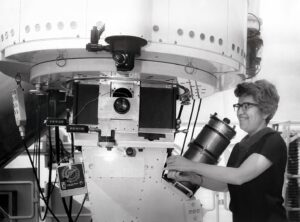
Whether it be the dark or the future, humans have always been afraid of the unfamiliar. This fear was on vivid display when Vera Rubin presented her seemingly bizarre findings on dark matter to her majority male colleagues in the 1970s. Further, she was ostracized as a woman in STEM, and her research was outright rejected. But after decades of relentless efforts, her groundbreaking research was finally acknowledged and paved the way for current studies on the mysterious dark matter.
Vera was born in 1928 and grew up in Washington D.C., taking an early interest in astronomy and encouraged to study the subject by her engineer father. Unfortunately, her high school teachers strongly discouraged her from pursuing higher studies in astronomy. But her love for astronomy prevailed, and she went on to study it at Vassar. After her graduation, she sought to continue her education at Princeton but was rejected because of prevailing gender biases. Yet again, she defied common conventions and managed to secure a degree at Cornell, studying under legendary physicists such as Richard Feynman, Philip Morrison, and Hans Bethe. It was there that she got her start to research. Later, she began work at the Carnegie Institution, where she would analyze numerous spiral galaxies using colleague Kent Ford’s sensitive spectrometer to measure the distribution of stellar velocities within a galaxy. A spectrometer measures the composition of an object, where each element emits a different wavelength of light. These wavelengths shift towards red and blue on the spectrum based on whether the object is moving away from or towards the observer, respectively, with the degree of shift corresponding to the speed of the object.

At the time, it was thought that stars at the borders of a galaxy moved slower than stars at the center, where mass and gravity was concentrated. Vera shattered that belief when she found that border stars moved just as fast as central stars. These findings hinted at an invisible source of gravity causing the peripheral stars to move so fast. The answer was dark matter, making up an astounding 90% of every spiral galaxy. Although received with immense suspicion by the astrophysical community, her findings were eventually accepted as valid and contribute to our current understanding of dark matter.
Today, the study of dark matter is growing tremendously. There is much debate surrounding it and many hypotheses as to what it really is. What makes the study of dark matter so hard is that it does not interact through nuclear forces and does not emit radiation. Despite these challenges, particle colliders such as the Large Hadron Collider are constantly trying innovative methods such as colliding placeholder particles and calculating the amount of energy absorbed by dark matter.
One thing is certain: none of our current research would be possible without the incredible strides made by women like Vera Rubin, who weren’t deterred by constant setbacks and persevered through gender restrictions and rejection from the scientific community. Because of her invaluable contributions to astronomy, the Vera C. Rubin observatory has been built in Chile in her honor. While the observatory does not study dark matter, it contributes majorly to the discovery of new supernovae and asteroids. Although the study of dark matter is still in its infancy, Vera believed in the philosophy of eternal learning. In her words, “Still, more mysteries of the universe remain hidden. Their discovery awaits the adventurous scientists of the future. I like it this way.”
Meera Desawale is a rising junior at Briarcliff High School. She is a space enthusiast and aims to share her passion with the community at large.






